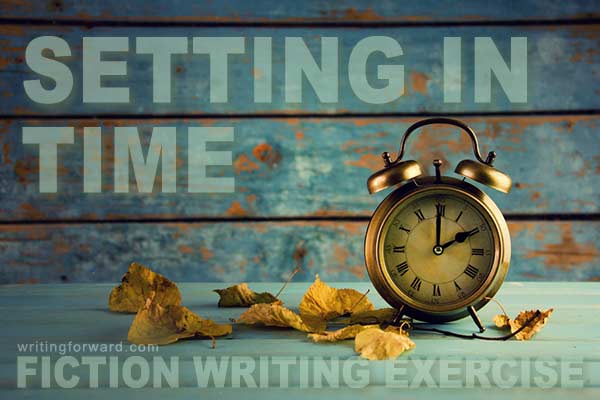Today’s fiction writing exercise is an excerpt from my book, Story Drills: Fiction Writing Exercises, which imparts lessons and techniques on the craft of storytelling and provides practical exercises for study and practice. This exercise focuses on story’s setting and more specifically, making sure readers know when every scene in a story takes place. Enjoy!
Setting in Time
An aspect of setting that is often overlooked is time—when a story takes place. This is an element of setting that historical authors pay close attention to, often conducting deep research to get every detail right—the clothes, the methods of transportation, and the society and culture as it existed at a particular moment in history.
But even authors of contemporary fiction must remain cognizant of a story’s timeline. When do the story events occur? What year? What season? What time of day?
In addition to establishing when a story takes place, we need to make sure readers always know where they are in a story’s timeline. If there’s a scene jump, did an hour pass? A day? A month? How do readers know?
Amateur authors often mark time by repeatedly stating when each scene takes place. It’s Monday or Wednesday, ten a.m. or six p.m. These repeated mentions of time can make readers feel like they should be keeping track of the timeline on a calendar. Establishing the time is best done subtly, unless the story requires concrete statements of time, as might be the case in a detective story or spy thriller.
Keeping readers in a story’s timeline without constantly reminding them of the day, month, year, or hour can be tricky. In most cases, all that matters is when the scene occurs in relation to a story’s timeline. So once the base timeline is established (hopefully at the beginning of the story), we can use various cues to help the reader understand how time is passing. Common techniques include phrases such as “a month later,” “the next day,” and “later that evening.” However, descriptions of the setting can also provide cues to inform readers about the time: the sun is rising, the moon is in the sky, the harvest has begun.
Study:
Find a story that spans a lengthy timeline, such as a generational saga. Make a list of ten significant time jumps in the story, with the first item on your list being when the story starts. For each time jump, find the sentence, paragraph, or phrase that establishes when the scene is set. Jot down a few words about the technique the author used to keep readers informed about the story’s location in its own timeline.
Practice:
Spend a few minutes developing a rough timeline for a story of your own. Make sure it spans at least three years and jumps to at least seven different points in time. Each time marker will denote when a scene takes place. Example: June 1977, evening; August 1977, afternoon; January 1978, morning. For each of these time markers, write a few sentences that establish a scene within the timeline.
Questions:
Have you ever become confused about a story’s timeline? This might be expected if you’re reading a time travel story, but what about other types of stories? Have you ever been reading a story and grown tired of the narrative constantly telling you what day, month, year, or hour it was in each scene?






My current wip is a story that covers years. I’ve had to work hard on when things happen. I found that at one point I had a child talking and walking, then later being very much a baby! Much work was done to correct this!
Yes, keeping track of time in a story can be a challenge! I also recommend rounding up some beta readers to help with finding inconsistencies like these. Good luck with your WIP!